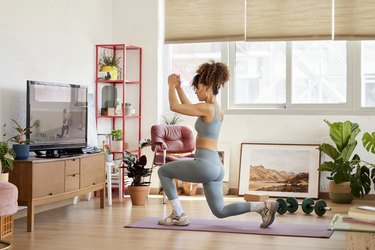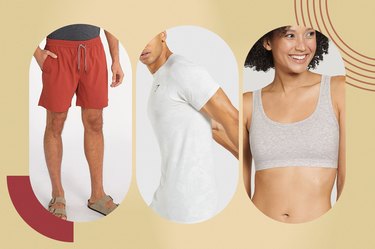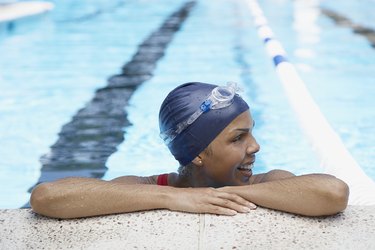
Psoriasis, an immune-mediated disease that can cause painful and itchy patches of red, scaly skin known as plaques, can make getting the recommended amount of exercise and strength training more difficult than it already is.
First, there's the psycho-social factor: When you're in the midst of a flare-up, you may struggle with self-confidence and avoid populated spaces like the gym or your regular group fitness class. Plus, the physical stress caused by a workout can increase inflammation and tax your immune system, causing symptoms to worsen. And sweat and friction from clothing, equipment and surfaces can further irritate your skin.
Video of the Day
But that doesn't mean that people dealing with psoriasis need to sit on the sidelines. "Exercise can be beneficial to almost any type of disease or state of health, as long as it's appropriately dosed for the person," says Grayson Wickham, DPT, physical therapist and founder of Movement Vault.
Wickham, who's worked with patients with psoriasis, recommends a low-impact, low-intensity strength workout when you're in the midst of a flare, as it can provide the benefits of resistance training without overly stressing your body or aggravating your skin. The one outlined below requires zero equipment and a small patch of floor space so you can do it in the comfort of your own home.
How to Do This Workout
Designed by Wickham, this 20-minute, low-impact workout provides full-body strengthening with no equipment. While each movement is challenging, this routine is more about maintaining a steady burn than breaking a crazy sweat. So, take your time and pay attention to form. Skip any movements that cause discomfort, or check out the tips below for modifying exercises and your space.
Perform the exercises in order as a circuit, completing 2 to 3 rounds. If you need to move slowly because you're feeling fatigued or need to limit perspiration, you can optimize your time by performing the lunge with rotation once and starting each of the following rounds with the squat. Also, feel free to reduce your reps as needed.
Things You'll Need
An exercise mat
Optional: medium-weight dumbbells or kettlebells
Check out more of our 20-minute workouts here — we’ve got something for everyone.
The Workout
1. Runner's Lunge With Rotation
Also affectionately referred to as "The World's Greatest Stretch," this mobility drill will bring your tissues up to a working temp without getting you super sweaty. It engages every major muscle group while loosening and lubricating your joints, including your hips, knees and ankles. And that thoracic twist just feels great.
- From a high plank position (face-down on palms and balls of feet, legs straight, back flat, core braced and shoulders and elbows stacked over wrists), step your right foot forward into a low lunge. Your right toes should be aligned with the fingers of your left hand.
- Rotate your torso toward your right knee and reach your right arm straight up toward the ceiling. Look up at your hand and hold for 5 seconds.
- Rotate your torso in the opposite direction as you lower your right arm and reach it behind your left arm.
- Holding the lunge position, repeat two more times, rotating both directions. Then, switch sides.
- Do a total of 6 reps (3 reps per side).
Tip
Work out in naturally cool, moderately humid spaces when possible. While heat and sweat can trigger a flare, a cranked-up air-conditioner (common in gyms and fitness studios) can be drying and irritating to the skin, according to the American Academy of Dermatology Association. If you’re stuck in an air-conditioned room, using a moisturizer can help.
2. Squat
The squat is a foundational movement that targets your quads and glutes while activating your core. You can add resistance by holding dumbbells at your sides or in the racked position at your shoulders. If you're up for a challenge but prefer to limit your skin's contact with equipment, try slowing down your reps or holding your position at the bottom of your squat for a few seconds.
- Stand with your arms at your sides and your feet a little wider than shoulder-width apart, toes pointed outward slightly.
- Keep your chest lifted and your spine straight as you hinge at your hips and push your butt back. Bend your knees and lower your hips until your thighs are parallel to the floor, or go as far as possible while maintaining good form. Allow your arms to drift forward and up for balance.
- Push through your feet and squeeze your glutes as you return to a standing position.
- Repeat for 15 to 20 reps.
Tip
“If something doesn’t feel right, try limiting your range of motion,” Wickham suggests. He explains that movement stretches the skin, which can irritate plaques. So, for example, if a full squat hurts the skin around your knees, go halfway or three-quarters of the way.
3. Dead Bug
The dead bug strengthens your entire core, including the deep core muscles responsible for stability, alignment and posture. Your torso remains stationary throughout the exercise, so you won't experience the friction you get with other core exercises, including crunches, sit-ups and V-ups.
- Lie on your back with your knees bent and feet lifted so that your shins are parallel to the ground. Reach both arms straight up toward the ceiling.
- Keeping your core braced and lower back pressed against the ground, extend and lower your right leg as you lower your left arm behind you. Go only as far as you can while keeping your spine neutral and in contact with the floor.
- Pause, then slowly return to the starting position.
- Repeat with the opposite arm and leg.
- Do a total of 12 reps (6 reps per side).
Tip
Don’t be afraid to double up your exercise mat or place a folded towel under a painful contact point, Wickham says. “If someone does have an area that’s a little irritated, sometimes adding some extra padding can be enough to make it OK,” he says.
4. Reverse Plank Hold
The reverse plank fires up your core and the entire posterior chain while giving you a deep stretch in your chest and shoulders. You'll also feel this hold in your triceps.
- Sit with your legs out in front of you and slightly bent and your heels on the ground. Lean back and place your palms on the ground behind you, fingers facing forward.
- Straighten your arms and legs and lift your hips into a reverse plank so your body forms a straight line from your head to your heels.
- Hold for 60 seconds or accumulate a total hold time of 60 seconds, taking breaks as needed.
Tip
The right apparel makes a difference, so experiment with various materials and fits. Wickham notes that some of his clients with psoriasis prefer wearing compression garments that provide a layer of protection, while others opt for lighter, loose-fitting clothes that promote air flow and don’t touch their skin.
5. Single-Leg Deadlift
Like the squat, the single-leg deadlift can be performed with added resistance (holding a dumbbell or kettlebell in both hands or the hand opposite the standing leg) or with your body weight alone. The hip hinge strengthens your glutes and hamstrings, and, because you're standing on one leg, challenges your balance.
- Stand with your feet about hip-width apart, allowing a soft bend in your knees. Shift your weight to your left foot and lift your right foot a few inches off the ground. (If you struggle to balance on one foot, you can use your right foot as a “kickstand” by gently resting your toes on the ground.)
- Hinge at your hips and lower your torso toward the ground, stopping when you feel a deep stretch in your standing leg. Float your right foot back behind you and use your arms to maintain your balance. Keep your back flat and your neck neutral.
- Contract your glutes and hamstrings as you return to a single-leg standing position.
- Repeat for 10 reps, then switch sides and do 10 more reps.
6. Bear Crawl
The bear crawl is low-impact and demands a relatively small range of motion, but you'll feel it everywhere, especially in your core, arms, shoulders and chest. Also, because you're balancing on just your palms and the balls of your feet, it's a smart pick for when you want your skin to make minimal contact with the floor.
- Start in a quadruped position with your knees directly under your hips and your wrists and elbows aligned with your shoulders.
- Keeping your back flat and core engaged, lift your knees so that just your palms and the balls of your feet are on the ground.
- Step the right foot and the left hand forward, then step the left foot and the right hand forward.
- “Crawl” back to your starting point by stepping the left foot and right hand backward, followed by the right foot and left hand.
- Repeat for 6 reps (1 rep= 2 steps forward, 2 steps back)


